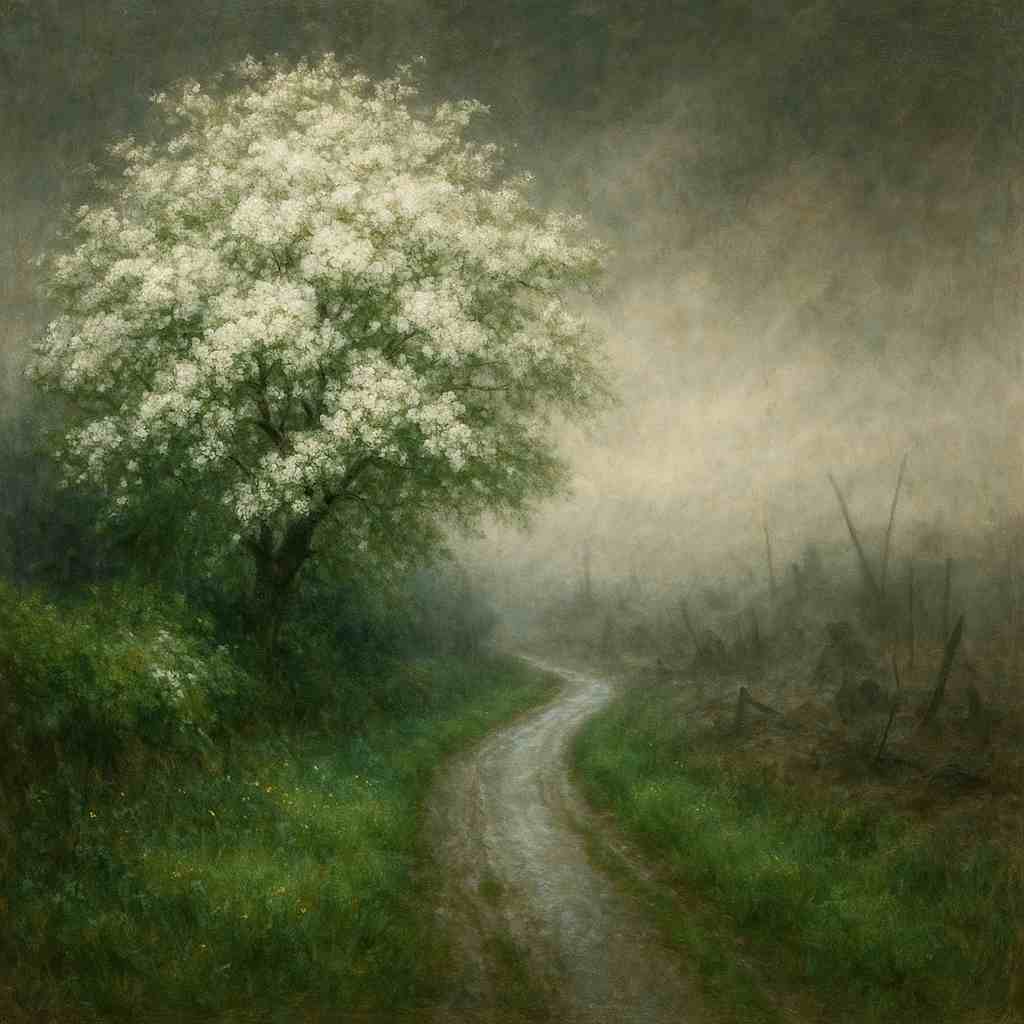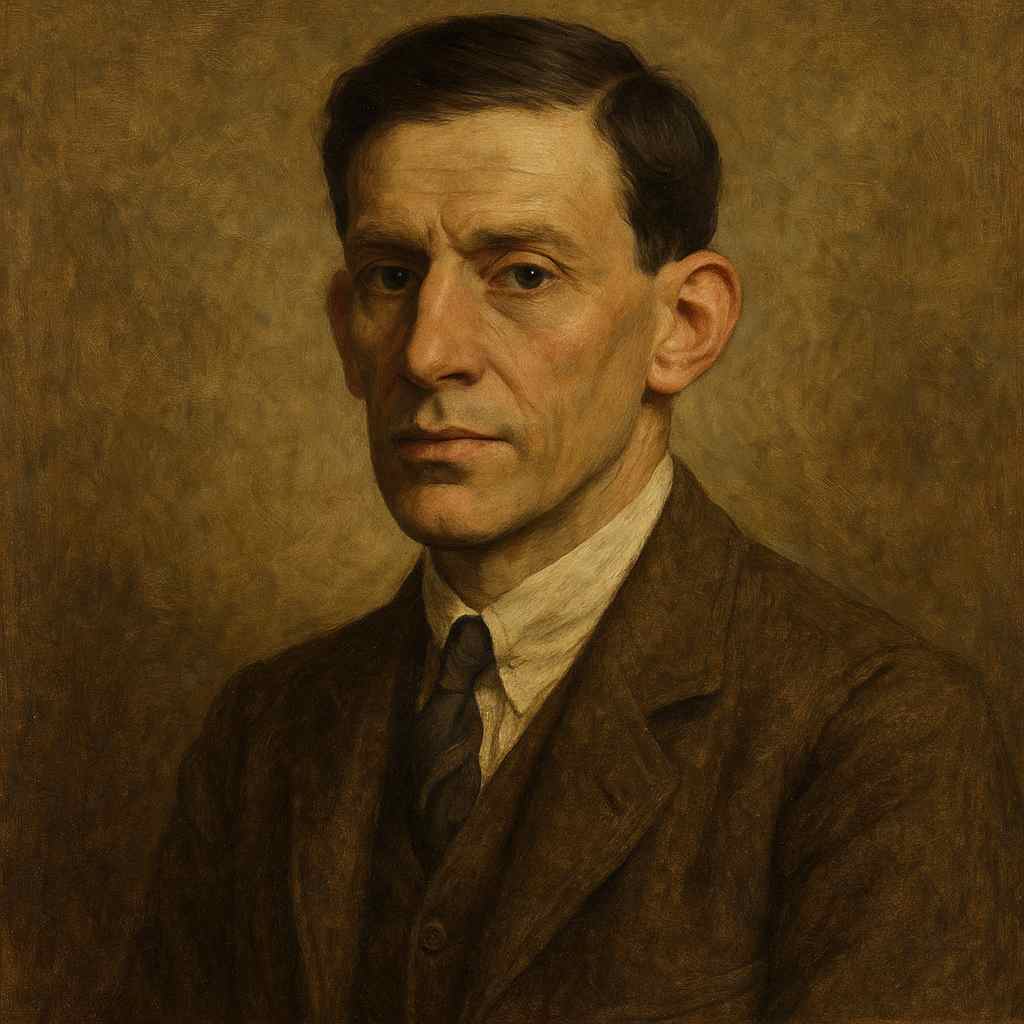The Hawthorn Tree
Siegfried Sassoon
1886 to 1967

Not much to me is yonder lane
Where I go every day;
But when there's been a shower of rain
And hedge-birds whistle gay,
I know my lad that's out in France
With fearsome things to see
Would give his eyes for just one glance
At our white hawthorn tree.
* * * * *
Not much to me is yonder lane
Where he so longs to tread;
But when there's been a shower of rain
I think I'll never weep again
Until I've heard he's dead.
Siegfried Sassoon's The Hawthorn Tree
Siegfried Sassoon’s The Hawthorn Tree is a deceptively simple yet deeply poignant poem that encapsulates the emotional turmoil of World War I. Written by one of the war’s most celebrated and critical poets, the piece reflects the tension between the pastoral beauty of England and the brutal reality of the trenches. Through its restrained language, evocative imagery, and emotional understatement, the poem explores themes of longing, loss, and the psychological toll of war. This analysis will examine the poem’s historical and cultural context, its literary devices, thematic concerns, and emotional impact, while also considering Sassoon’s broader oeuvre and the philosophical implications of his work.
Historical and Cultural Context
To fully appreciate The Hawthorn Tree, one must situate it within the broader framework of World War I poetry. Sassoon, along with Wilfred Owen and Rupert Brooke, was a defining voice of the war, though his perspective evolved from early idealism to biting disillusionment. Unlike Brooke’s romantic patriotism (The Soldier) or Owen’s graphic depictions of suffering (Dulce et Decorum Est), Sassoon often employed irony and understatement to convey the psychological devastation of war.
Written during or shortly after the war, The Hawthorn Tree reflects the home front’s anxiety. The poem’s speaker is not a soldier but someone left behind—likely a mother, lover, or sibling—whose daily life is haunted by the absence of a loved one “out in France.” The hawthorn tree, a symbol of English pastoral beauty, becomes a focal point of longing, representing everything the soldier has lost and everything the home front clings to.
The hawthorn itself is culturally significant in English folklore, often associated with hope, protection, and the arrival of spring. Its white blossoms contrast starkly with the “fearsome things” the soldier witnesses, reinforcing the divide between the innocence of home and the horrors of war. This juxtaposition was a common motif in war literature, as seen in Edward Thomas’s As the Team’s Head Brass or Ivor Gurney’s The Silent One, where rural England serves as both a comfort and a painful reminder of what has been disrupted.
Literary Devices and Structure
Though the poem is brief, Sassoon employs several key literary devices to amplify its emotional weight.
1. Imagery and Symbolism
The poem’s central symbol, the hawthorn tree, embodies the idealized England that soldiers were ostensibly fighting to protect. Its whiteness suggests purity and innocence, a stark contrast to the mud and blood of the trenches. The “shower of rain” and “hedge-birds whistle gay” create a sensory, almost idyllic scene, reinforcing the tranquility of home. Yet this beauty is undercut by the knowledge that the soldier “would give his eyes” just to see it again—a phrase that carries both metaphorical and literal weight, given the war’s brutality (gas attacks and artillery often left men blind).
2. Repetition and Parallelism
The poem’s two stanzas mirror each other structurally, beginning with the same line: “Not much to me is yonder lane.” This repetition emphasizes the speaker’s attempt to downplay their attachment to the landscape, only to betray their deep emotional investment. The parallelism between the stanzas also highlights the shared suffering of the soldier and the one left behind—both are trapped in their own forms of anguish.
3. Understatement and Irony
Sassoon frequently used understatement to convey profound emotion. The speaker claims the lane is “not much” to them, yet the entire poem revolves around its significance. The final lines—“I think I’ll never weep again / Until I’ve heard he’s dead.”—are devastating in their restraint. The speaker does not indulge in melodramatic grief but instead reveals a quiet, gnawing dread. This technique forces the reader to sit with the horror of the unspoken: the possibility that the soldier may never return.
4. Contrast and Juxtaposition
The poem thrives on contrasts:
-
The cheerful birdsong vs. the “fearsome things” in France.
-
The mundane lane vs. its emotional significance.
-
The speaker’s outward calm vs. their inner turmoil.
These juxtapositions deepen the poem’s emotional impact, illustrating how war distorts perception, making even the simplest pleasures bittersweet.
Themes
1. The Fragility of Home and Memory
For the soldier, the hawthorn tree is a fleeting memory, a symbol of a life that feels increasingly distant. For the speaker, it is a fragile anchor, a reminder of what could be lost. The poem suggests that war does not only destroy lives but also erodes the sanctity of home, turning familiar landscapes into sites of anxiety.
2. The Psychological Toll of Waiting
The speaker’s grief is anticipatory—they are not mourning a death but living in fear of one. This reflects the experience of many on the home front, who endured the agony of uncertainty. The line “I think I’ll never weep again / Until I’ve heard he’s dead” captures the numbness that comes with prolonged dread, a theme Sassoon explored in other works like The Hero, where a mother is fed false comfort about her son’s death.
3. The Disconnect Between Front and Home
The soldier and the speaker are united in longing but divided by experience. The soldier yearns for the hawthorn tree, while the speaker can barely tolerate its presence, knowing what it represents. This disconnect was a recurring concern in war literature, as soldiers often returned to find that civilians could never truly understand what they had endured.
Comparative Analysis
The Hawthorn Tree can be fruitfully compared to other war poems:
-
Wilfred Owen’s The Send-Off: Both poems explore the home front’s ignorance of the war’s true cost, though Owen’s tone is more cynical.
-
Thomas Hardy’s In Time of ‘The Breaking of Nations’: Hardy’s poem also contrasts war with rural continuity, but where Hardy finds solace in nature’s indifference, Sassoon’s nature is saturated with human sorrow.
-
Sassoon’s own Does It Matter?: Both poems use understatement to critique war’s lasting trauma, though The Hawthorn Tree is more personal and less satirical.
Biographical and Philosophical Insights
Sassoon’s own wartime experience—his bravery in combat, his public protest against the war’s prolongation, and his eventual return—infuses the poem with authenticity. His friendship with Wilfred Owen and mentorship under Robert Graves also shaped his poetic voice, which blends lyrical beauty with stark realism.
Philosophically, the poem raises questions about memory and loss. Can an idealized past (symbolized by the hawthorn tree) ever be reclaimed after trauma? The speaker’s ambivalence suggests not—the tree is both a comfort and a torment, much like memory itself.
Emotional Impact
What makes The Hawthorn Tree so moving is its restraint. There are no grand declarations of grief, only quiet, unbearable tension. The final lines linger like a held breath, leaving the reader with the awful weight of anticipation. This emotional resonance is why Sassoon remains one of the most enduring voices of WWI literature—he captures not just the horror of war, but the quiet devastation it leaves behind.
Conclusion
The Hawthorn Tree is a masterclass in understated emotion, using simple imagery and repetition to convey profound sorrow. By juxtaposing pastoral beauty with the specter of death, Sassoon illustrates war’s far-reaching consequences, affecting not just soldiers but those who wait for them. In doing so, he elevates a seemingly modest poem into a universal meditation on love, loss, and the fragile endurance of hope.
For readers today, the poem remains a haunting reminder of war’s personal cost—an artefact of grief that transcends its historical moment to speak to all who have loved and feared for another.
This text was generated by AI and is for reference only. Learn more
Want to join the discussion? Reopen or create a unique username to comment. No personal details required!



Comments
No comments yet. Be the first to comment!